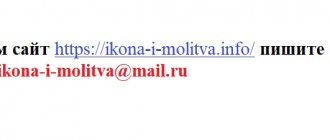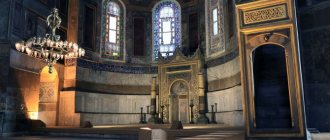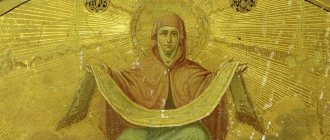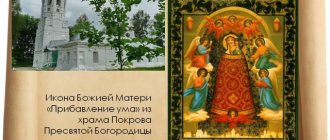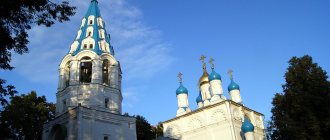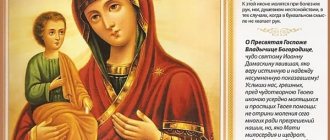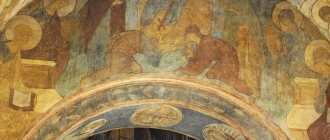The name of the icon Economissa is translated into Russian from Greek as Housekeeper or Keeper of the House. The image of Economissa is one of the five most famous miraculous icons residing on Athos, an area in Greece that is inhabited by monks and dotted with monasteries.
In the image, the Most Holy Theotokos holds the Infant Christ in her arms, and the Athonite saints Athanasius of Athos and Michael of Sinai stand before the Son and Mother.
The Mother of God sits on a throne together with the Child, who, sitting upright and holding a scroll in one hand, blesses those praying with the other. Two angels stand behind the Mother and Son.
Compositional features of the holy face
An icon is not only a beautiful picture, each image has a symbolic and spiritual meaning. Images of the Mother of God are distinguished by several types, respectively, by their compositional features. The Icon of the Mother of God “Ekonomissa” is a panahranta or the All-Tsarina.
In its composition it is similar to another famous shrine - “Hodegetria”, but has differences in some details. The characteristic signs of panahranta are:
- placement on the throne;
- Christ is on the left hand of the Mother;
- The Mother of God is necessarily dressed in the vestments of the queen.
As for the image itself, it consists of several figures:
- Mother of God;
- Child Christ;
- Saints Athanasius and Michael of Sinad.
The elders were honored to be depicted due to their history: Saint Athanasius directly became an eyewitness to the miracle that the Mother of God performed, this will be written below, and Michael of the Synod became known as the archbishop who opposed iconoclasm and was thrown into prison for his strong convictions, where he later and died. Michael is painted in his archbishop's vestments, holding an open scroll in his left hand, and Athanasius has a small picture of the cathedral, symbolizing the Athos Lavra.
The entire composition emphasizes that “Ekonomissa” is an image not only written on Mount Athos, but also protecting the holy place.
Important! All boards created on Mount Athos have distinctive features. One of them is the emphasized greatness of the Queen of Heaven.
The monks from the mountain always tried to portray the Mother of God exactly as the most worthy of mortals. Several methods are used for this:
- Attire: color - rich red, as a symbol of the royal family and, at the same time, a symbol of suffering;
- The Mother's veil covers her entire body, symbolizing motherhood;
- A blue dress symbolizing purity;
- The image of three stars on the vestment are symbols of the immaculate conception, birth and death. Blue is the dominant color in the composition, indicating the importance of the virgin birthright;
- An image of two angels above Mary's head: kneeling on clouds directly above their heads and holding the Queen's crown;
- Some copies depict the angels slightly differently: they are positioned behind Mary and raise their hands in prayer while their wings are folded. Their whole appearance speaks of reverence for the Mother of God;
- The board also clearly shows the throne, several saints and the ongoing construction below - this is the construction of a monastery on Mount Athos, which would not have taken place without the blessing of the Mother of God. You can also consider the episode of the meeting of the Mother of God and Saint Athanasius in front of the miraculous spring.
There is also one alternative copy of the icon, where on the sides of the composition there are hagiographical marks that contain episodes from the lives of the saints. Below is the Athonite Lavra, and above the angels is the non-canonical Holy Trinity.
ICON OF THE VIRGIN "ECONOMISSA" ("HOUSE BUILDER")
Composition options
The images may differ in some details, but the concept of the icon does not change its meaning.
- Two angels are depicted above the heads of the Mother of God. They kneel on the clouds, each supporting a crown over the head of the Blessed Virgin.
- On some Economiss icons, angels stand behind with their hands raised in prayer, their wings folded behind their backs. They respectfully await orders from their mistress.
- The throne and the upcoming saints are depicted on the clouds; ongoing construction is visible in the lower part of the composition. A large number of monks (of different ages, in different clothes) are working hard, building the walls of the monastery. A little to the side is shown an episode of communication between the Mother of God and St. Athanasia, they are standing in front of the source.
- There is an ancient version of the icon with hagiographic stamps. They are located on the sides of the main composition and depict episodes from the life of devotees of the faith. Below is an image of the Lavra. Above the angels is the Holy Trinity (in the non-canonical version - the Elder, Christ and the dove).
- The Savior does not hold a scroll in his hand, but blesses those praying with both hands. The Most Pure One holds it with both hands.
History of the holy image
In 958, the ascetic Athanasius began the construction of the Lavra on Holy Athos. At that time it was something special, because the now familiar monastic system did not yet exist. Then the hermits lived separately, their life was full of suffering and hardship. Despite this, a number of monks were constantly on Mount Athos. But after one crop failure, a severe famine occurred, which, unable to withstand, the monks left the mountain.
Afanasy, as the founder, held out until the last and did not want to leave in search of food. But time passed, the hunger became unbearable, and there was less and less food left, and one day the elder decided to go in search of food.
While going down, he saw a woman and was very surprised, because according to the laws, women do not have the right to ascend to the holy place. The stranger asked Afanasy where he was going, and he, without answering her question, began to speak indignantly about the ban and ask the stranger how she was allowed here.
The woman behaved confidently and indicated that Athanasius should behave modestly and respectfully with her. Because he doesn’t know who is in front of him. The elder was taken aback, but began to speak to the woman more politely, and also told everything about the famine and the fact that the monks had left the monastery. The woman said that from now on no one in the monastic monasteries will ever need food, for the monks will always have it.
When Athanasius asked the woman who she was, she answered simply - the Mother of God, and when the elder did not believe it and demanded proof, a miracle happened: the woman told him to hit the stone with his staff, which the elder did. From the impact, the stone broke in two, and clean water began to flow from its core. The monk realized that the Queen of Heaven was actually in front of him and wanted to bow to her, but the woman was no longer there.
Returning to the monastery, he walked through the monastic warehouses and froze at what he saw - all the shelves and cabinets were bursting with food supplies. From that day on, the monks began to return and hunger never came to that area again.
Important! The source still exists today; it is considered miraculous because it has the ability to heal serious illnesses. A church and resting place were built near it, since it is located in the middle of the road to the shrine.
And the icon “Ekonomissa” was created by the monks in honor of the significant meeting and the patroness of Athos.
The Economissa Icon - what it helps with
After turning to the Mother of God in front of her Economissa icon, believers, according to many testimonies, receive miraculous help in various circumstances related to financial difficulties:
• In difficulties with finances, • Material disasters, • Housing issues and the need to obtain a mortgage or loan, • The threat of hunger, • The inability to complete a planned task, • Difficulties in business and work • About getting rid of despondency; • About calm and peace in the family, at work, in the country; • About the correct management of an enterprise, firm, team.
Days of celebration and location of the “House Builder” icon
Like other images, “Ekonomissa” has its own days of remembrance and celebration; on the same day the memory of the righteous Athanasius is also honored. This day is July 18, when annually troparions are served and prayers to the Mother of God “Economissa” are read.
Throughout its existence, the icon never left Athos. Many believers are familiar with it only through written lists. It is located in the Church of the Picturesque Spring on Mount Athos. Many requests came to the monks from various churches around the world to bring the shrine and perform a religious procession, but all were refused.
Attention! No less interesting is the fact that “House Builder” has never been seen by any woman. They are still not allowed into the Sacred Site, so only male pilgrims can see the face.
But the list of the Housebuilder is kept in the center of Moscow in the All Saints Church and in Belarus in the St. Nicholas Church. There is also a temple of the Mother of God “House-Builder”, which was built in 1998 in the city of Severny (Moscow region).
Icon “Image of the Most Holy Theotokos Economissa”
Orthodox online store Svyatsy.Org - Icons of the Most Holy Theotokos “Ekonomissa” (“House-Builder”).
Prayer to the icon of the Mother of God “Economissa” or “Housebuilder”
The prayer before the icon of the Mother of God “Economissa” is very powerful. It is considered especially effective on the day of the celebration of the Shrine - July 18. On this day, St. Athanasius of Athos is also venerated, with whose name the appearance of a miraculous image is associated.
We advise you to study Prayer for grandchildren
Text of the prayer request to the Mother of God
The prayer text that needs to be said in front of this icon of the Mother of God in Russian may sound like this:
“Oh, Most Honorable and Most Pure Lady of Heaven, Mother of God, Abbess of Saint Athos! Accept my humble prayer and offer it to Your Son, our Lord, may He save my sinful soul with His grace
Pay attention to me, a sinful and unworthy Servant of God (proper name), show your mercy and grant me salvation in difficult times. By your intercession before the Lord, the Lover of Mankind, bring about salvation for me, since I, the accursed one, cannot save myself in the vanities of the world.
Ask the Lord to forgive all my sins; I sincerely repent of the sins I have committed and pray for their forgiveness, so that I can appear at the hour of the Last Judgment with a pure soul before the throne of the Lord. I am perishing in the abyss of sin and without your help and support. Help, Most Holy Theotokos, to find me eternal life, accompany me through vanity and lead me away from worldly temptations, grant me a sinless existence, filled with joy and peace. The terrible wrath of God will descend in the form of natural disasters, when people will wallow in their sins and will not strive for a righteous life according to God’s commandments. I ask you, Lady of Heaven, to prevent this. Remember that the Savior, Your Son, Jesus Christ, gave his life for us. Help me, weak-willed and weak, to find pure and unshakable faith and not to stray from the righteous path. Deliver me from sinful vices and vile character and help me find happiness and prosperity in a bright and pure way. I humbly kneel before Your image and pray for help. Amen".
How to offer prayer and how it helps
This prayer should be offered exclusively before the icon of the Most Holy Theotokos “Economissa”. It is clear that the original, which is located on Holy Mount Athos, can only be seen by men. And this is not very easy to do, due to the complexity of obtaining permission to visit a holy place.
But prayer will also be effective in front of the list. It can be found in the very center of Moscow in the All Saints Church, which is located on Slavyanskaya Square. In addition, in the Northern microdistrict of the capital in 1998, the Church of the Icon of the Blessed Virgin Mary “Economissa” was built.
The prayer near this icon should be read with deep sincerity.
It is important to remember that an appeal to the Mother of God should not turn into an ordinary request for money or a request to receive household material goods. The prayer should contain a plea for the gift of fortitude and the desire to get rid of sinful temptations
The power of prayer is faith
A prayer appeal to the Great Intercessor is made with a sincere message, as the holy fathers say, “from the heart.” There are known cases when the Housebuilder of Mount Athos not only saved from want and deprivation, but also healed from infirmities and diseases. So, back in the 18th century, a pious, hard-working woman and her little daughter were healed from illness, hunger and want. A sick and needy woman constantly prayed to the miraculous image and kissed it, the miracle happened, the life of the family improved. Thus, the prayer book of the Russian land showed the world once again the miracles of her mercy and love for the human race. Prayer to the Economissa icon has more than once helped those in need and those asking for help. The main condition is to formulate your prayer message sincerely and with love.
The second miraculous appearance of the comforter of the human race
The second legend says that during Athanasius’s lifetime another miraculous appearance of the Most Holy Theotokos occurred. For the second time, the monk Matthew, known among the brethren in the Lavra for his zeal and piety, saw the Most Pure Virgin. During the service, he suddenly saw the image of the Virgin Mary, accompanied by two angels. She approached each monk and presented them with coins, depending on the degree of zeal during prayer. Matthew also got a few coins. Thus, the house-builder of the Holy Mountain once again showed her patronage and care over the holy monastery. Since then, one of the most revered shrines of Mount Athos has become the “Economissa” - the icon of the Mother of God.
Appearance of the icon
The icon presents the Mother of God, who sits on a throne and holds a baby with her left hand.
On the right stands Saint Michael, who gave his life for the faith. One day, the king’s servants came to the temple where Michael served and said that if he did not destroy all the icons in the temple, he would be sentenced to death. The saint refused to destroy the images of God and chose death, thereby not betraying the Lord. On the left side stands Saint Athanasius. He was one of those who built the Lavra for the Great Mother. During construction, the Devil interfered and hindered people; with the help of his machinations, he immobilized Athanasius’ assistants, and they could not do anything. Saint Athanasius knelt down and began to pray to the Most Pure One, and the Demon was expelled into the dungeon, and nothing else hindered the construction of the Lavra.
The clothing in which the Mother of God is presented also carries its own meaning:
- a cloak the color of red wine, speaks of the suffering of the Virgin Mary;
- a dress of soft blue color means innocence;
- the hair hidden under the shawl speaks of her motherhood.
Not a single woman has ever set foot on the blessed land...
Pilgrims from crisis-ridden countries come to venerate the miraculous image. At the same time, it absolutely does not matter what faith the newcomer professes, the icon “Ekonomissa” (“House Builder”) helps everyone with sincere prayers and requests. The only exception: women cannot get to the icon, because they are completely prohibited from visiting Mount Athos, so as not to disturb the peace and tranquility of the monks living there. This is what the Mother of God commanded many centuries ago, when she chose the Holy Mountain as her inheritance, and this prohibition has been observed for many years. Women have the opportunity to worship copies of the image or copies from it, which are also not without miraculous power. Repeated requests from the Orthodox for the opportunity to release the icon outside the monastery were invariably refused, since the “Economissa” - the icon of the Mother of God - is the custodian of the entire Holy Mount Athos.
Akathist to the Mother of God “Economissa”
Remembrance Day of the Image is July 18. On this day, the akathist and troparion are read and only then a prayer is said. The date of veneration of the icon is combined with the day of veneration of Athanasius of Athos. They go together according to the canons of church history. Their story begins from the very beginning, when famine struck the inhabitants of Mount Athos.
Words of prayer:
When reading a prayer, you should not believe in magic and the sudden appearance of money in the house. During reading, the spiritual and material spheres are reconciled, and gradually prosperity comes into a person’s life.
After receiving what you need, be sure to read a prayer of thanks to the Mother of God. You can also thank from the bottom of your heart in your own words.
The prayer to the Mother of God is very powerful. The image is one of the most important in the history of the Orthodox Church. Virgo answers everyone whose thoughts are pure.
Miracles associated with the icon
Miracles with the icon are described more often. They mainly concern the return of financial well-being, but there are also historically significant ones.
So, a week before Maslenitsa in 1846, a demon attacked one person. The man turned away from the true path and began to indulge in mental carelessness. All actions lasted several days. But the Queen of Heaven intervened and took part in the healing of the human soul.
The monk saw in a dream a meal on a solemn day with the presence of the abbot and all the brotherhood of the monastery. Such gatherings happened very rarely and there was always food on the table. And on this day, everyone but him had modest dishes in front of them. A roast stood in front of the monk. A heavenly wife entered the hall, accompanied by two angels.
The Mother of God looked sternly at the monk and left in complete silence. After the man woke up, pious thoughts returned to him. He again became God's obedient.
Prayer texts
O Most Honest Lady Theotokos, our All-Honorable Mother Abbess, of all Orthodox monasteries of monastic life, in the holy Mount Athos and throughout the entire universe! Accept our humble prayers and offer them to our All-Bountiful God, that He may save our souls by His grace. Look upon us with Thy merciful eye and bring about our salvation in the Lord, for without the mercy of our Savior and Thy holy intercession for us, we, the accursed, will not be able to accomplish our salvation, for our life has been tarnished in the vanities of the world, for the time of Christ’s harvest is approaching. The day of the Last Judgment has arrived.
We, the accursed, perish in the abyss of sin, for our negligence, according to what was spoken by the holy fathers, the first leaders of the angelic life according to the flesh: as the last monastics, through the negligence of their lives, will become like worldly people, which will come true today, for our monasticism floats with its life on the sea of life. amidst great storms and bad weather: for our holy abodes remain in the dust for the sake of our sins, our All-Righteous Lord Jesus Christ, so benevolent, but we, unworthy, have no place to bow our heads.
O our sweetest Mother Abbess!
Gather us, the scattered flock of Christ, into one and save all Orthodox Christians, grant us heavenly life with the Angels and all the saints in the Kingdom of Christ our God, to Him be honor and glory with His Beginning Father and with the Most Holy, Good and Life-Giving Spirit forever and ever. Amen".
Troparion tone 4
Representation is terrible and shameless, / do not despise, O Good One, our prayers, / All-sung to the Mother of God, Merciful of the faithful to the House-Builder, / establish Orthodox residence, / save our country, / and protect all Orthodox Christians living in it and// you gave birth to God, O One Blessed One.
Where is the "Economissa" image located?
Not everyone can afford to travel to Mount Athos, and women are not allowed to enter there. Famous lists are located in different cities and countries:
- in the St. Nicholas Church (Bobruisk district, Belarus) - made with the blessing of the abbot;
- in the All Saints Church in Moscow (Slavyanskaya Square);
- in the village Northern (Moscow region);
- a rather old list (1896) is located in the Trinity Monastery in Tashkent.
You can also purchase the image as a keeper for the hearth. The image of the “House Builder” would also be appropriate in the office - since this icon patronizes an honest business that feeds not only the owner, but also many employees. You can choose any icon, as long as it complies with the canons. The answer to prayers does not depend on the price of the icon; it is solely a matter of diligence and personal faith. The image must be kept clean - wiped from dust, protected from damage.
The icon must be consecrated in the temple. If the image is bought in a church shop or monastery, then this is not necessary (all goods are sanctified before sale). Usually they do not require money for the consecration of objects. In general, donations for any sacraments are voluntary according to the rules of the Russian Orthodox Church. If the icon needs to be transported to another place, it is customary to cover the holy face with paper or linen. This piece of paper is then burned. Of course, the board or paper itself on which the icon is made is not an object of worship, but respect for the prototype must be shown.
May your prayers be heard...
The miracles of faith through the prayers of Orthodox Christians at the Economissa icon are known throughout the world. In the 19th century, several deeply religious peasants from the Smolensk province went to bow to Mount Athos. After spending several days on the Holy Mountain, praying to many Athos shrines, we went to bed at night. One of the pilgrims had a dream that their native places were in great trouble, but the intercessor from heaven sent help and the people were saved. Having told their dream to the abbot of the monastery, the peasants were sent to the Great Lavra to the image of the “House-Builder”. After praying for three days at the icon, the peasants received a sign that their prayers were heard. Returning home, the pilgrims learned that a terrible disaster had been averted from their native places through their prayers: hunger and poverty, the death of all living things, had been averted. The Economissa icon heard the prayer books. What do the Orthodox pray to her for, what does the Abbess of Mount Athos protect the human race from through their prayers? The answer to these questions is the numerous miracles performed by the image.
